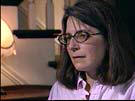|
CBC MARKETPLACE: HEALTH » LEAD
Lead in drinking water
Broadcast: March 27, 2001 | Producer:
Ines Colabresel; Research: Leonardo Palleja & Jenny Wells

Wendy Leigh-Bell of
Hamilton, Ontario, was warned not to drink her water
after tests found high lead levels in her drinking water |
Lead is dangerous to everyone and particularly to children.
It can cause learning disabilities and lowered IQ. So for
decades Canadians have been taking steps to lower the amount of
lead in our tap water. We have had some success.
But lead in drinking water remains a problem for many
Canadian families. Part of the reason may be because of the way
we test for lead.
Across the country, Canadians have spent hundreds of millions
of dollars digging up streets and sidewalks to replace water
pipes that leach lead into drinking water. But the work has just
begun. It will take years and cost millions more to replace old
lead pipes with copper.
- Related story:
Home Water Filter Systems
Two years ago Wendy Leigh-Bell watched more than just her
children digging up the front yard. The water pressure in her
home had reached an all-time low. That is sometimes a sign of
old pipes.

Barbara McElgunn of the
Learning Disabilities Association of Canada maintains
there is no safe level for lead exposure |
Leigh-Bell decided to have her water tested. Not long
afterward, city officials called her at home.
"We received a phone call that we ought not to drink the
water…because we had a level that was three times the allowable
limit for lead," Leigh-Bell told Marketplace.
The house still had lead pipes coming from the street. The
city replaced part of the pipes and the family paid $600 to get
the rest removed. To be safe, they now drink only bottled water.
Lead has a toxic effect on the brain, especially for young
children whose brains are still developing.
Barbara McElgunn of the Learning Disabilities Association of
Canada says that reduced IQ is just one result of lead exposure.
She maintains there is no safe level for lead.
The effects of lead that scientists and pediatricians are
most concerned with now go beyond reduced IQ. There are concerns
arising from research into the effect of lead on emotional
reactivity, aggression, social confidence and social
functioning.

"It illustrates the fact
that everybody's at some risk," says University of North
Carolina lead expert, Dr. Richard Maas |
Lead in our water is not a new problem. In 1988,
Marketplace reported on the danger of lead in school
water supplies.
The report caused Canadian officials to lower
the maximum allowable lead level for drinking water.
But what is the state of the lead in Canada's
drinking water today? Marketplace tested water from 50
homes across the country.
We sampled water from homes in:
- Saint John, New Brunswick
- Toronto
- Hamilton
- Winnipeg
- Vancouver
Half the homes were built before 1970,
half were built after 1970.
The results? Fifteen of the fifty homes
had lead levels above the national guideline. One even had
levels at 250 times the maximum allowable limit.
Most of the problems came from homes built
before 1970. Of the 25 homes we tested that were built before
1970, eleven had high lead levels.
We told Dr. Richard Maas about our test
results. He
| "It illustrates the
fact that everybody's at some risk," Maas told
Marketplace. "If you're in an older home, you're
probably at more risk." |
is a scientist at the University of North
Carolina and an internationally renowned specialist on lead in
water.
"It illustrates the fact that everybody's at
some risk," Maas told Marketplace. "If you're in an
older home, you're probably at more risk."
When should your water should be tested? While
you're sleeping, water is at rest in your pipes for hours. If
there's lead anywhere in your system, it will leach into the
water. It takes just two hours for standing water to absorb a
lot of lead.
If there is lead in your water, you are
most likely to find it at first draw; the water that comes out
when you first turn on the tap. There's usually less lead when
the tap has been run or flushed, as it's called in the industry.
For each of the 50 homes in the Marketplace
study, we tested the water twice: first thing in the morning and
once after the water had been run for three minutes.
Each of the 15 homes with high lead levels got those numbers
when the sample was taken at first draw, before the water was
run. After the water had been run for three minutes, most homes
were free of excessive lead. But two still had problems, even
after the water had been run.
In the United States, if you're assessing lead contamination
of drinking water you are required by law to take water from the
first draw.
In Canada, when federal and provincial governments test
drinking water for lead, they do so only after it's been run for
three minutes. That's a strategy that's gained some critics.
"If you don't want to find the lead problem that's a good
sampling strategy for doing that," Dr. Richard Maas said.
Dave Green, Health Canada's representative on the
federal-provincial committee that drafts the guidelines for
Canada's drinking water, says the key is to determine the
average amount of lead that is in the water a person consumes.

Health Canada's Dave
Green says regulations for testing for lead in water in
Canada are adequate. Canada does not require samples to
be taken at first draw as the United States does |
Green disagrees with the suggestion that water should be
tested at first draw, given that our tests showed that flushing
the water reduced lead levels in 13 of the 15 samples.
"I would say that one method of trying to estimate how much
lead is consumed by people in their drinking water in the way we
have it on a flushed sample is just as valid as taking first
flushed samples, as the U.S. does," Green said.
Richard Maas disagrees.
"If you do all your sampling after a three to five minute
flush, then you are greatly underestimating the average
concentration of lead in the water because you're only looking
at flushed water," Maas told Marketplace.
Dave Green notes that his department tries to publicize as
much as possible that people should let their water run for
three to five minutes in the morning, before drinking it. He
admits, though, that he has no idea whether most people realize
that.
As for Wendy Leigh Bell, we re-tested for lead in her house
tap water. It came in at 3.5 times the allowable maximum.
The lead could be coming from any one of several sources:
more lead pipes, lead solder on the copper or even lead in the
faucet. It's tough to trace. |